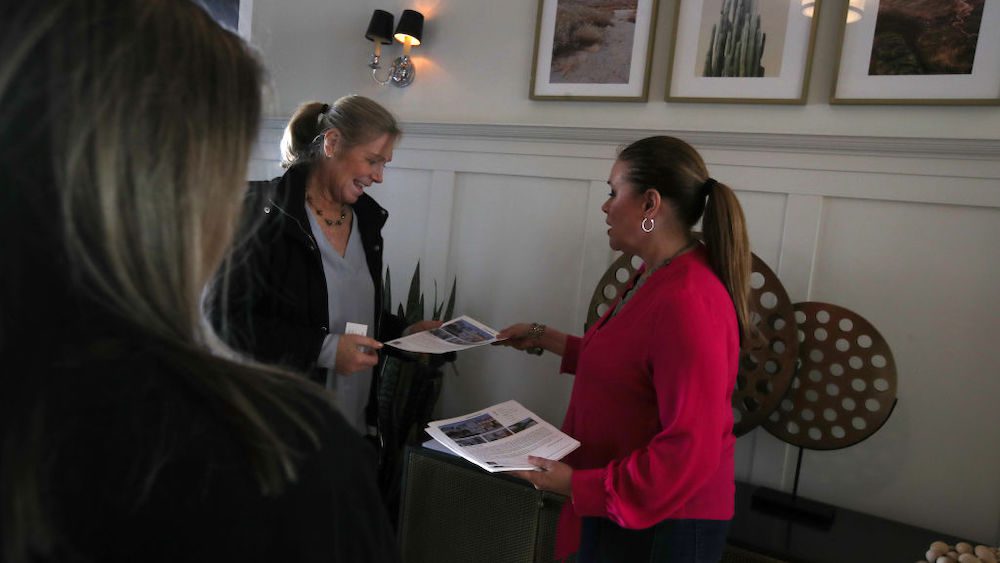
Justin Sullivan/Getty Images
The mortgage market turned red hot over the summer, posting its biggest three months since the financial crisis.
Lenders extended $700 billion of home loans in the July-to-September quarter, the most in 14 years, according to industry research group Inside Mortgage Finance. Mortgage originations for the full year are on pace to hit their highest level since 2006, the peak of the last housing boom.
Falling interest rates spurred homeowners to trade higher-rate mortgages for lower-rate ones to save on monthly payments. Refinancings kept mortgage lenders busy, though home sales haven’t recovered as much as economists expected.
Home sales have risen on an annual basis for the past three months, according to the National Association of Realtors, reversing a slowdown that persisted for more than a year. But sales fell about 2% in September from August, indicating the market is struggling to maintain its newfound momentum.
A decline in mortgage rates often takes longer to boost home purchases than refinancing because people need to shop for a home first. That could mean a few more months of improving sales as buyers who were drawn back into the market by lower rates continue to close on their purchases.
“The last few months have given us glimmers of hope that low rates are inducing existing home sales upwards,” said Ralph McLaughlin, deputy chief economist at CoreLogic Inc. “It looks like there is a healthy runway for home sales to tick up.”
Wall Street Journal
Refinancing activity jumped 75% from a year earlier in July and August, according to data and technology firm Black Knight Inc. A record 11.7 million people would have saved at least 0.75 percentage point on their mortgage rate by refinancing in early September, Black Knight said.
Eric O’Sullivan bought a house in January in Old Lyme, Conn., when mortgage rates were in the mid-4% range. But rates have steadily fallen over the course of the year, prompting his mortgage lender to alert him to the potential to lower his rate. He refinanced this month at 3.49%.
His house also was appraised for more when he refinanced because he had put substantial work into it. The additional equity allowed him to do away with his mortgage insurance, further lowering his monthly payments.
“I wasn’t expecting to be able to refi,” Mr. O’Sullivan said. “It didn’t even cross my mind.”
Executives at Wells Fargo & Co., the nation’s largest mortgage lender, said this month that the bank extended $5 billion more in mortgages last quarter than in the quarter before, with refinancings making up a greater share of its originations. They expect the fourth quarter to be at about the same level as the third.
Chris Dutz lowered his interest rate to 3.75% from 4.25% when he refinanced his Colonial-style home in Millstone, N.J., this month. He said he waited about a year for the best rate.
He also switched from a Federal Housing Administration-insured loan to a conventional loan, which eliminated some fees. He estimates he is saving about $300 a month, meaning the refi costs will pay for themselves within a few years.
“It was all about timing when I wanted to pull the trigger,” he said. “I won’t touch my loan for a long time.”
Ralph DiBugnara, a senior vice president at Cardinal Financial Co. who handled Mr. Dutz’s loan, said that his business has been up 15% to 20% over the past three months or so. The growth has been a mix of refinances and purchases, he said.
The third quarter was a welcome rebound for an industry that was struggling to make money just months ago, alleviating some worries about underlying fragility in the mortgage market. Independent nonbank lenders now account for around half of all home loans, and they don’t have as much capital as banks to shield them in a downturn.
“I hope that people don’t get carried away and think this will last forever,” said Ted Tozer, a fellow at the Milken Institute and former president of government mortgage corporation Ginnie Mae. “They are hopefully socking away some of the cash they need so they can have a situation where they are better able to deal with a downturn when it does come.”
Larry Rideout, chairman of Boston-based Gibson Sotheby’s International Realty, said rates haven’t been as big of a boost to the purchase market as he expected because younger buyers have learned to take low rates for granted.
“We see it as extremely attractive,” Mr. Rideout said. But “the millennials have seen this rate for many years.”
The post Falling Rates Boost Mortgage Market to Precrisis Levels appeared first on Real Estate News & Insights | realtor.com®.
source https://www.realtor.com/news/real-estate-news/falling-rates-boost-mortgage-market-to-precrisis-levels/
No comments:
Post a Comment